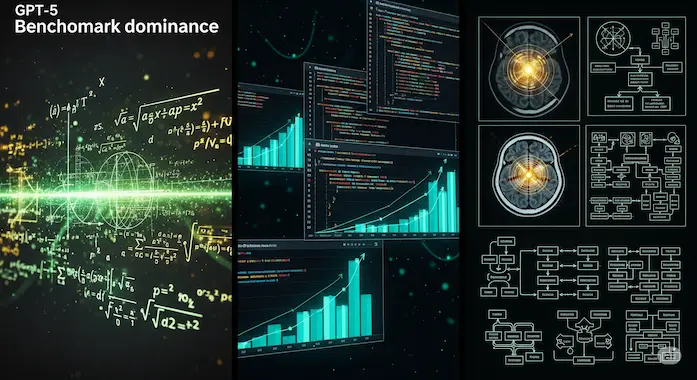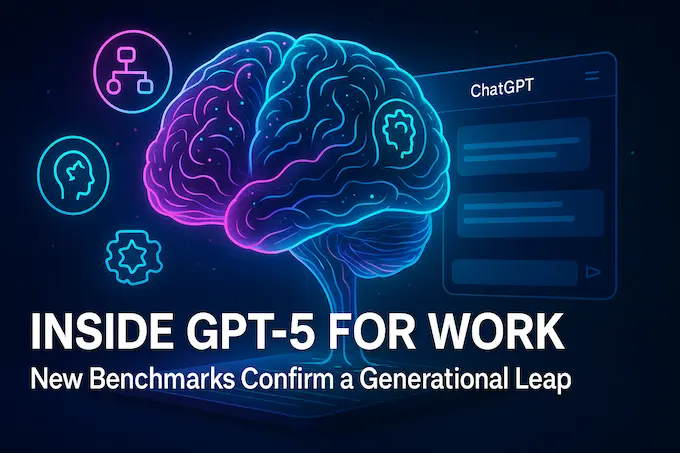1. A Launch That Hits Different
When OpenAI rolled out GPT-5 on August 7, 2025, the internet stopped scrolling and started whisper-shouting. The energy felt different from every earlier model reveal. Maybe it was the OpenAI Summer Update drumroll, or the way CEO Sam Altman compared the new model to “a PhD who never sleeps,” yet the real reason sits deeper: this release shifts the center of gravity in applied AI.
ChatGPT’s interface now runs a unified stack powered by GPT-5. A smart router detects whether your prompt needs brisk recall, long-form reasoning, or full-blown agentic planning, then silently picks the right sub-model. The swap is instant. You ask, the system decides, you get an answer. No settings page, no jargon. Just speed.
The rollout touches every tier. Free users glimpse GPT-5 until they hit a soft cap, then fall back to a mini variant. Plus subscribers enjoy longer sessions. Pro subscribers get unlimited runs and early access to “GPT-5 Pro,” a beefier version tuned for huge chains of thought and tool use. Enterprise and Education tenants unlock even bigger quotas next week, positioning ChatGPT for business as table stakes rather than a novelty.
OpenAI’s updated pricing looks aggressive. The GPT-5 price: $1.25 per million input tokens and $10 per million output tokens for the standard tier, with mini and nano editions slashing those numbers further. When rivals charge midsingle digit input rates and double-digit output rates, cost leadership matters. Companies crunch budget sheets and notice the savings immediately.
Table of Contents
2. Under the Hood, A Model That Routes Its Own Thoughts

To grasp why GPT-5 for Work feels smarter, imagine the model as a studio band instead of a single virtuoso. There’s a rhythm guitarist handling easy chords, a lead guitarist riffing through tricky progressions, and a conductor choosing who steps forward each bar. That conductor is the new “thinking router.”
- Fast Path: a stripped-down network that spits out short answers, summaries, and formulaic code edits with near-zero delay.
- Deep Path: a denser network that opens its gates only when confronted by an AIME geometry proof, a tricky merge sort problem, or a legal brief.
- Router: a lightweight policy that measures prompt complexity, context length, and user hints like “think step by step,” then dispatches the request accordingly.
The result feels natural. Casual conversations stay snappy, yet heavy prompts trigger chain-of-thought passes without manual toggles. This self-selection powers the headline claim: GPT-5 is both faster and smarter.
OpenAI also infused the model with persistent memory. Tell GPT-5 you prefer metric units and it remembers across sessions. Mention your startup’s tech stack and it will reference that stack days later. The memory is opt-in and can be wiped anytime, a nod to enterprise privacy.
Agentic tool use, long teased, arrives built-in. Want GPT-5 agentic capabilities to scrape your inbox, draft slides, and schedule follow-ups? Connect Gmail and Google Calendar, grant permissions, and watch the agent juggle tasks without human babysitting. Early testers report that the agent recovers gracefully from tool errors, retries with alternate APIs, and summarizes outcomes in plain language.
3. Benchmarks: Numbers With Teeth

OpenAI’s slide deck brims with charts, but three data points tell the story.
3.1 Academic Reasoning
On the AIME 2025 benchmark GPT-5 scores 99.6 percent with tools. That trounces the legendary GPT-4o line and edges past Gemini 2.5 Pro, reclaiming the math crown. The margin may look tiny, yet at Olympiad level each extra percent slices error counts by hundreds.
3.2 Software Engineering
The model posts 74.9 percent on SWE-bench results while spending fewer tokens and making fewer tool calls than its predecessor. Pair those savings with lower token prices and you see why dev teams care. They ship code faster and cut inference bills in parallel.
3.3 Multimodal Mastery
On MMMU, a college-level visual reasoning suite, GPT-5 clocks 84.2 percent, comfortably leading prior OpenAI models and nudging past Google’s Gemini in validation tests. Screenshots of the evaluation show the model solving diagram puzzles, reading hand-drawn charts, and interpreting radiology images with a doctor-like bedside manner.
Add the vision scores to its audio, video, and spatial reasoning tallies, and GPT-5 benchmark headlines practically write themselves.
4. Living With GPT-5 Day to Day

4.1 Coding in the Flow
Cursor’s founders shared a demo where GPT-5 fixed a platformer game bug, refactored shaders, and improved Tailwind styles, all inside a single chat thread. Each refactor applied lint rules, passed tests, and respected TypeScript types. Developers called the experience “pair programming with someone who actually reads the docs first.”
4.2 Research and Data Science
Immunologist Dr. Derya Unutas fed raw flow-cytometry tables into GPT-5. The model spotted an overlooked variable and predicted experimental outcomes not yet tested. Days later, lab results confirmed the prediction. These anecdotes feel dramatic, yet they repeat across finance, marketing, and biotech. GPT-5 surfaces correlations, proposes follow-ups, and drafts grant-ready hypotheses.
4.3 Product Teams and Non-Coders
Designers ask GPT-5 for an infinite canvas app prototype. Within minutes, they drag images onto a resizable board rendered in React Three Fiber, complete with physics-aware panning. Product managers load thousands of customer tickets and receive prioritized feature roadmaps that align with sprint capacity. HR leads paste policy PDFs and get employee-friendly summaries with linked citations.
The thread connecting these stories is trust. Users say GPT-5 hallucinates less, cites sources more precisely, and asks clarifying questions when data feel ambiguous. That shift from “answer now, apologize later” to “pause, clarify, then answer” signals a maturing safety culture.
5. GPT-5 vs Claude 4.1, Gemini, and Friends
Competitive debates flare in every Slack channel. Is GPT-5 better than Claude? Does Gemini still lead in multimodal retrieval? Let’s zoom out.
| Metric | GPT-5 | Claude 4.1 Opus | Gemini 2.5 Pro | Grok 4 Heavy |
|---|---|---|---|---|
| Agentic Coding (SWE-bench) | 74.9 | 74.5 | 67.2 | 58.6 |
| Competition Math (AIME 2025) | 99.6 | 78.0 | 99.2 | 91.7 |
| Multimodal Visual (MMMU) | 84.2 | 77.1 | 82.0 | — |
| Retail Tool Use | 81.0 | 82.4 | — | — |
| Pricing per Million Input Tokens | $1.25 | $15 | $1.25 | $3.00 |
Claude sneaks a narrow win on retail tasks, likely owing to Anthropic’s system-1 alignment tricks, yet GPT-5 dominates broader reasoning while undercutting cost by a factor that CFOs cannot ignore. The verdict: if you need one model across departments, GPT-5 now owns the value axis.
6. Economics: When Intelligence Gets Cheap Enough to Spread
Token pricing rarely excites people outside procurement, yet the new curves reshape the market. Each generation, OpenAI chopped per-token input costs. GPT-5 price halves GPT-4o’s input fee while keeping output fees steady. The mini and nano tiers then slide even lower, hitting $0.25 and $0.05 per million inputs respectively.
Consider a SaaS startup processing ten gigabytes of PDF text weekly. Under GPT-4o the monthly input bill sat above $12,000. Migrating to GPT-5 mini drops that to roughly $1,200 while raising answer quality. That delta bankrolls headcount or fuels growth marketing. Multiply this across thousands of small firms and you see why rivals scramble.
7. Agentic Futures and the Road to AGI
OpenAI avoids overusing the AGI acronym, yet the subtext remains. A model that routes its own cognition, wrangles tools, preserves memory, and runs economical enough for daily use nudges the Overton window again.
- GPT-5 agentic capabilities handle multi-step plans such as drafting a legal contract, fetching precedent cases through Westlaw, inserting citations, and formatting everything in Markdown.
- High-context windows reach 400,000 tokens, letting analysts stuff entire 10-K filings or giant codebases into a single prompt.
- Extended output ceiling hits 128,000 tokens, letting the model write full white papers, not mere outlines.
None of this means artificial general intelligence has arrived. Continuous learning, robust world models, and unsupervised intention alignment still loom. Yet it becomes harder to argue that we need a wholly new paradigm before hitting broad economic impact. GPT-5 for Work moves AI from an accessory to a co-worker.
8. Workflows Rewritten, Jobs Re-Imagined
8.1 Developers
The best engineers now offload boilerplate, migration scripts, and documentation to GPT-5, focusing on architecture. Junior devs lean on the model for onboarding. Pair programming shifts from typing assistance to thought partnership.
8.2 Knowledge Workers
Analysts feed spreadsheets into GPT-5, request pivoted insights, then ask follow-up “why” questions. The dialogue feels like brainstorming with a curious colleague.
8.3 Creative Teams
Writers co-draft book chapters, generate alt text, or storyboard podcasts. Designers iterate brand palettes by chatting about mood boards. Editors press GPT-5 into fact-check duty because its hallucination rate shrank to single digits.
8.4 Scientific Research
Labs already run simulated experiments overnight. GPT-5 predicts probable results, flags anomalies, and recommends the next ten most promising assays. Time-to-discovery shortens, budgets stretch, and grad students sleep an extra hour.
“GPT-5 did in minutes what took my postdoc team a week,” one PI told me. He smiled, then sighed, aware that deadlines just tightened accordingly.
9. The Human Side of Faster Thinking
Every leap in capability triggers a wave of social adaptation. Early fax machines made office workers busier, not freer. GPT-5 may replicate that pattern. As drafting or coding becomes trivial, managers will raise the bar on originality and judgment. The cognitive ladder slides upward.
Still, there’s reassurance in the way GPT-5 encourages cross-disciplinary dialogue. You can drop psychology case studies alongside SQL logs and ask for an ethical A/B test design. The model threads the data points, then surfaces tradeoffs you might miss. It doesn’t replace the hard human calls, yet it compresses the prep work so meetings focus on decisions, not slides.
10. Where This Story Goes Next
Version six will arrive faster than skeptics expect. Recent leaks hint at modular training pipelines, swap-able sensory heads, and hybrid recurrent layers built for reasoning over months of logged context. If that roadmap holds, today’s marvel will soon feel quaint.
For now, GPT-5 stands as the best all-purpose language model you can actually buy, slot into production, and trust with serious tasks. It owns the value curve, carries fewer hallucinations, and bends the cost line down. Whether you run a research lab, a fintech startup, or a one-person newsletter, the question is no longer “Should I try AI?” It is “Which processes can I hand off to GPT-5 this quarter?”
Intelligence keeps getting cheaper faster than everything else. Smart businesses will reorganize before their competitors even draft a memo.
11. Quick-Start Playbook for Builders
You have the API keys, a backlog brimming with “someday” ideas, and a mandate to move. Follow this eight-step sprint to turn GPT-5 for Work into tangible wins.
- Sketch the Workflow, Not the Prompt
Map the start and finish of the job, including data inputs, tool calls, and human checkpoints. The clearer the scaffolding, the better GPT-5 agentic capabilities can shine. - Choose the Right Flavor
o Standard for balanced cost and depth
o Mini for chat-heavy SaaS widgets
o Pro when you need exhaustive chain-of-thought runs or 400K-token windows - Token Budgeting
Keep input messages terse. Let the model iterate internally. Monitor logs for runaway output. Every saved kilotoken compounds under the current GPT-5 price model. - Ground with Retrieval
Hook a vector database to inject domain facts. This slashes hallucinations and keeps answers in line with company policy. - Guardrails and Tests
Write unit tests for prompts the same way you test code. Validate quotes, numerical outputs, and references. The goal is “trust, but verify.” - User Feedback Loops
Capture thumbs-up, thumbs-down, or structured ratings. Fine-tune a small adapter only if patterns of failure emerge. Many teams over-optimize too early. - Observability
Log latency, cost, hallucination rate, and user satisfaction. Dashboards tell you when to switch to GPT-5 mini or roll out caching. - Incremental Release
Start with read-only tasks like summarization. Graduate to write-actions and tool invocation after the logs look healthy.
The playbook converts hype into habit. Within days you will have live traffic, metrics, and a sense of where the model adds the most leverage.
12. Cost–Benefit Snapshots
- Solo Creator
Maya runs a two-person newsletter. She pipes her outline into GPT-5 each morning, receives a polished draft, then spends an hour on voice refinements. Output doubled. Subscription churn fell. Net cost? Under ten dollars a week. - Mid-Market SaaS
A 60-employee CRM vendor embedded ChatGPT for business features. Sales reps auto-generate follow-up emails, support staff triage tickets, and the analytics team uses SQL explanations generated on demand. Monthly spend sits at twelve cents per user, yet ticket resolution time dropped by one-third. - Fortune 500
A global retailer ingested millions of product descriptions into a retrieval layer. GPT-5 benchmark evaluations showed higher accuracy in attribute extraction compared to their custom BERT pipeline. Closing that gap cut return fraud by three percent, worth tens of millions annually. Even with heavy usage, the monthly API bill lands below one hundred thousand dollars, pennies in context.
13. The Limits, Candidly
Every tool has sharp edges. Red-team audits ordered by regulators revealed four recurring risk pockets.
- Subtle Hallucinations in Niche Domains
In pharmacology edge cases, the model still fabricates obsolete dosage ranges. Always ground with a vetted source. - Over-Confidence Bias
Removing hedging makes prose crisp, but it can mask uncertainty. When stakes are medical or legal, require citations and cross-checks. - Privacy Surprises
Memory features remember what you let them. Err on the side of “off” until governance policies catch up. - Tool Misfires
In long chains of automated calls, a failed API or unexpected JSON schema can crash the chain. Add heartbeat checks and graceful fallback prompts.
These are solvable problems, not deal breakers. Clear policies, layered validation, and alerting will contain the rough edges.
14. Governance and Metrics Framework
Large organizations ask two questions: “How do we keep this safe?” and “How do we prove ROI?”
- Accuracy Score: Percent of responses that pass factual audit.
- Turnaround Time: Wall-clock latency from request to answer, including tool calls.
- Cost per Outcome: Dollar spend divided by tasks completed.
- User Satisfaction: Simple five-star scale captured in product telemetry.
- Escalation Rate: How often the system punts to a human. Lower is not always better; healthy caution keeps trust high.
Set quarterly targets, bake the metrics into dashboards, and review at the same cadence as uptime or sales funnels.
15. A Glimpse at 2026: The Probable Roadmap
Insiders hint that OpenAI’s research wing experiments with memory layers that write to external stores, letting the model “sleep” and awaken with refined synaptic weights. If that matures, the boundary between fine-tune and inference blurs.
Meanwhile, industry chatter suggests a multi-agent orchestrator nicknamed “Hive Mind.” Picture dozens of GPT-5 instances, each tuned to a specialty, voting on answers in real time. Early demos reduce hallucinations by another forty percent.
Competitors will not stand still. Anthropic signals a Claude 4.2 update optimized for agent simulation. Google’s Gemini team prototypes an audio-first assistant that makes voice interactions effortless. The device wars will restart, yet OpenAI Summer Update proved that aggressive iteration and ruthless cost discipline sway the market.
16. Final Take: Your Next Quarter Starts Now
Every executive deck this month will include a slide that asks, in polite fonts, “Is GPT-5 better than Claude?” The fuller question is whether your organization can afford to wait while peers experiment.
OpenAI just lowered the price of top-tier reasoning, widened context windows, and stitched memory into the user experience. The switch unlocks new product lines, trims support queues, and upgrades every dashboard fed by language.
If you lead engineering, add a line item for SWE-bench results improvement and budget a hack week. If you own analytics, pilot the model on that stubborn report backlog. If you run HR, draft an AI policy, then test the onboarding bot your recruiter always wanted.
Intelligence has become an API call, with pay-as-you-go pricing and enterprise SLAs. The early movers already feel the lift, the laggards will watch churn graphs spike. Where you land on that curve is now a matter of scheduling, not theory.
Pull the trigger. Route a few workflows through GPT-5, measure, refine, and repeat. By the time you finish the second sprint, you will wonder how you shipped anything without a tireless, context-hungry PhD in the loop.
GPT-5 is not a magic wand. It is a power tool. And like every good tool, its value compounds in the hands of teams willing to pick it up today.
Azmat — Founder of Binary Verse AI | Tech Explorer and Observer of the Machine Mind Revolution.
Looking for the smartest AI models ranked by real benchmarks? Explore our AI IQ Test 2025 results to see how today’s top models stack up. Stay updated with our Weekly AI News Roundup, where we break down the latest breakthroughs, product launches, and controversies. Don’t miss our in-depth Grok 4 Review, a critical look at xAI’s most ambitious model to date.
For questions or feedback, feel free to contact us or browse more insights on BinaryVerseAI.com.
1. What sets GPT-5 apart from earlier OpenAI models?
GPT-5 runs on a dual-path architecture, pairing a lightning-fast lightweight network for simple prompts with a deeper reasoning engine for tough problems. An intelligent router decides which path to use, so replies stay quick when you’re chatting and rigorous when you’re coding or analyzing data. Add a 400K-token context window, memory that recalls user preferences, and top scores on AIME 2025 and SWE-bench, and you have a model that simply outclasses GPT-4o and GPT-4.5.
2. How much does GPT-5 cost through the API?
The standard GPT-5 price is $1.25 per million input tokens and $10 per million output tokens. Lighter workloads can choose GPT-5 mini at $0.25 in and $2 out, while GPT-5 nano drops to $0.05 in and $0.40 out. Those tiers let startups prototype for pennies and enterprises scale without sticker shock.
3. Does GPT-5 really cut hallucinations and boost factual accuracy?
Yes. Internal audits show the model slashes hallucination rates by roughly six-fold compared with GPT-4o and drops deceptive answers from 4.8 percent to 2.1 percent. Benchmarks like GPQA, HealthBench, and the updated GPT-5 benchmark suite back up those gains in the lab and in the wild.
4. Can GPT-5 plug into my existing business stack?
Absolutely. GPT-5 for Work ships with built-in connectors for Gmail, Google Calendar, and other SaaS staples. Its agentic layer can call APIs, read docs, and loop through multi-step workflows, turning ChatGPT for business into a full-fledged productivity partner instead of a chat widget.
5. Is GPT-5 better than Claude 4.1 or Google Gemini 2.5 Pro?
Across the big public metrics the answer is yes. GPT-5 edges Claude on AIME 2025 math, beats Gemini on multimodal reasoning, and still comes in at about one-twelfth Claude’s input cost while matching or undercutting Gemini’s pricing. For most teams that blend of speed, accuracy, and affordability makes GPT-5 the front-runner.
6. What are the “agentic capabilities” of GPT-5?
Agentic capabilities refer to GPT-5’s ability to act as an autonomous “agent” to complete multi-step tasks across different applications. With user permission, it can connect to tools like Gmail and Google Calendar to perform workflows like reading emails, drafting responses, and scheduling meetings without requiring constant human guidance. Early tests show it can recover from errors and manage complex tool chains effectively.
7. What makes GPT-5 specifically good for business and enterprise use?
Beyond its enhanced reasoning and reliability, GPT-5 is designed for the enterprise with several key features:
A Unified System: No need for employees to select different models for different tasks.
Persistent Memory: It can recall user preferences and project context across sessions (opt-in).
Cost-Effectiveness: The new pricing model makes it significantly cheaper than both previous OpenAI models and current competitors for comparable tasks.
Trust and Safety: The dramatic reduction in hallucinations and deceptive answers makes it a more trustworthy tool for high-stakes business work.

